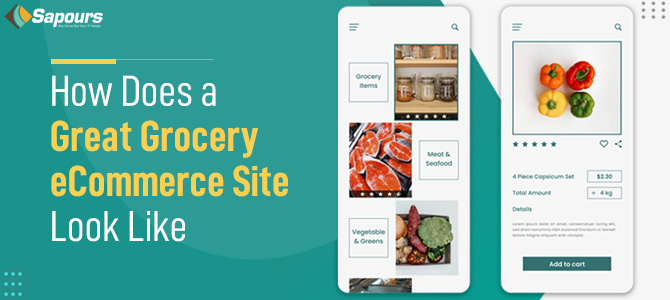By 2024, the eCommerce industry would represent 21.8% of the total retail sales.
Unsurprisingly, the proliferation of web applications and the resulting undeniable convenience of shopping online is something that every brick-and-mortar retailer is trying to accommodate and emulate.
Grocery eCommerce is no stranger to this ever-surging digital inclination, especially as the world enters the new normal. This is very well illuminated by the fact that the United States alone recorded grocery eCommerce sales worth $95.8 billion in 2020. The numbers for 2021 would be even better, with a projected YoY growth of 17.8%.
The pandemic has brought in fundamental changes in grocery shopping. Even after the pandemic is over, studies show that a vast majority of consumers will continue to go online for groceries shopping.
Admittedly, the industry is ripe for opportunities to be grabbed by businesses of all sizes. The question is, how can the online grocery retail operations be readied for this eventuality?
As one might expect, the answer lies in the implementation of an intuitive, service-oriented, and user-responsive retail model – a great grocery eCommerce site, to be precise.
But what does “great” really mean? For that, let’s find out the aspects that make for an all-embracing in-vogue grocery eCommerce website.
Streamlines the Purchase Cycle
It’s all about putting the power in the consumer’s hands by making it possible to purchase just-in-time products at their convenience. This means there should be no hassles when it comes to making the choices and subsequently transacting.
Businesses can bring this to realization by adopting the SAP Spartacus headless commerce architecture because it:
- Facilitates a unified view of the product at all times and across every operational store
- Triggers personalized product recommendations based on cross-channel product management and customer engagement features.
In that light, an ideal headless commerce grocery site is characterized by its ability to:
- Clearly delineate product and product group categories
- Provide a dynamic and intuitive shopping experience on the storefront
- Filter, sort, and categorize the shopping cart on demand
- Suggest and recommend dynamic shopping combinations
Not to mention that end-to-end seamlessness also depends on the smoothness of micro-operations, including payment processing via a trustworthy payment gateway.
Unifies the Front- and Back-Office
Imagine a scenario where a customer adds spices to their cart and hits the checkout button to reserve it. At the same time, a different customer looking through the same storefront opts to buy the same product. Everything would be fine if there’s enough perpetual inventory, but what if the opposite is true?
In that case, the backend trigger of displaying “out of stock” as soon as all the product quantity is reserved would prove to be a great way to communicate the condition of the item, thus avoiding failed orders. When the stock is replenished, the product display is transformed into an “in stock” one with the appropriate product-level attributes.
This is where unified commerce architecture comes in handy because it can seamlessly synchronize data between the frontend and backend platforms of an eCommerce grocery store. At the same time, it can maintain concurrency in stock monitoring so that businesses and consumers alike are well informed about the availability of a product at any given time.
Evidently, end-users will not have to deal with the wasted time of the potential order cancellations and forced restocking, thanks to the frontend displays of the product availability.
Ensures High-Grade CX
Another remarkable aspect that contributes to the overall efficiency of an eCommerce grocery platform is the constant delivery of a flawless customer experience (CX). This falls in line with the justifiable hype around CX’s importance, especially in the context of on-the-spot purchasing.
GlobeNewswire reports that almost 50% of consumers are subjected to impulse purchase decisions based on the eCommerce site’s user experience.
Implementing a state-of-the-art headless commerce grocery site can be a great way to achieve this. As such, there are many ways to ensure satisfaction on the CX front. For example, the customer can be talked into customizing the product (such as a pizza) they are about to buy in the way that suits them best.
Or, when the desired quantity exceeds that in the stock, a similar product can be pitched as an alternative to adding to the cart. If that simply won’t do, then the customer can be shown the restocking time of the product in question. The idea is to create a custom, self-tailored shopping experience every step of the way.
Sapours’ SAP Commerce Grocery Retail Accelerator
From a 50% reduction in implementation time and costs to 40% YoY growth, Sapours’ Spartacus-based Grocery Accelerator is a solution that strives for a higher eCommerce grocery storefront adoption and customer satisfaction. More profoundly,
- It’s a solution that enables businesses to get on board with Grocery eCommerce by deploying an optimized, unified headless commerce architecture
- It integrates products and inventory data, which is coherent at all times – thanks to SAP CAR (Customer Activity Repository)
- It promotes PWA-based web-optimized sites which deliver a smooth UI and a rich shopping experience
- It ensures a streamlined, optimized order process by helping create shopping combinations on the fly
- It empowers businesses to offer prompt buyer-friendly service because of seamless data synchronizations between the frontend and the backend systems, and much more.
The Road ahead for Grocery eCommerce
An excellent grocery eCommerce site gives the end-users a pleasant, satisfying experience while taking away any fear of miscommunication from the business side. It translates to increased opportunities to close more deals and achieve better business performance.
It’s time to back your grocery retail operations with Sapours’ SAP Commerce Grocery Accelerator. Connect with us to know more.

